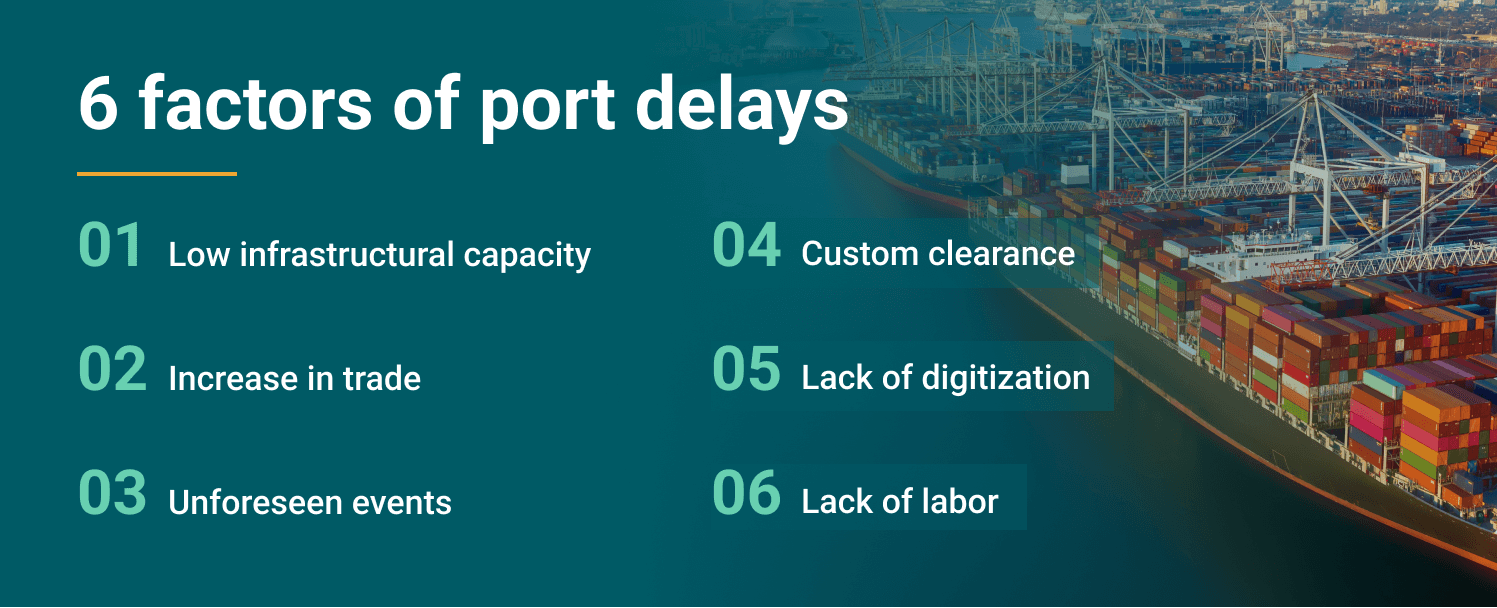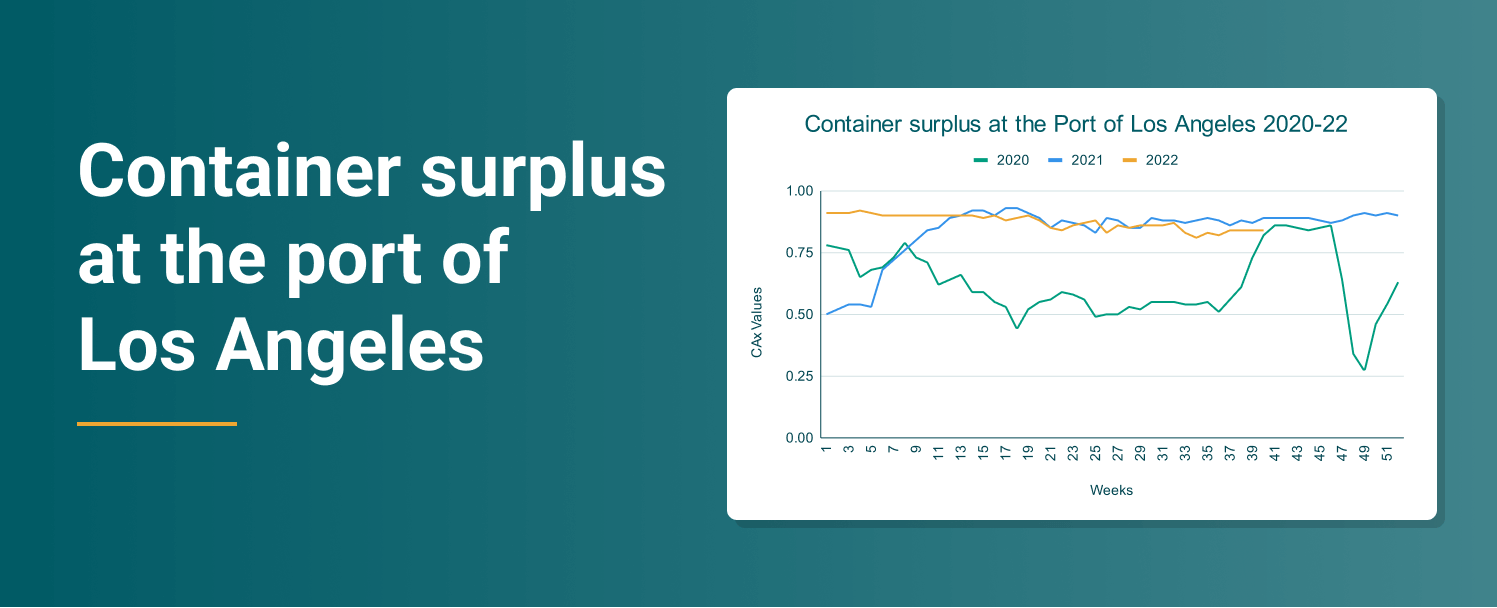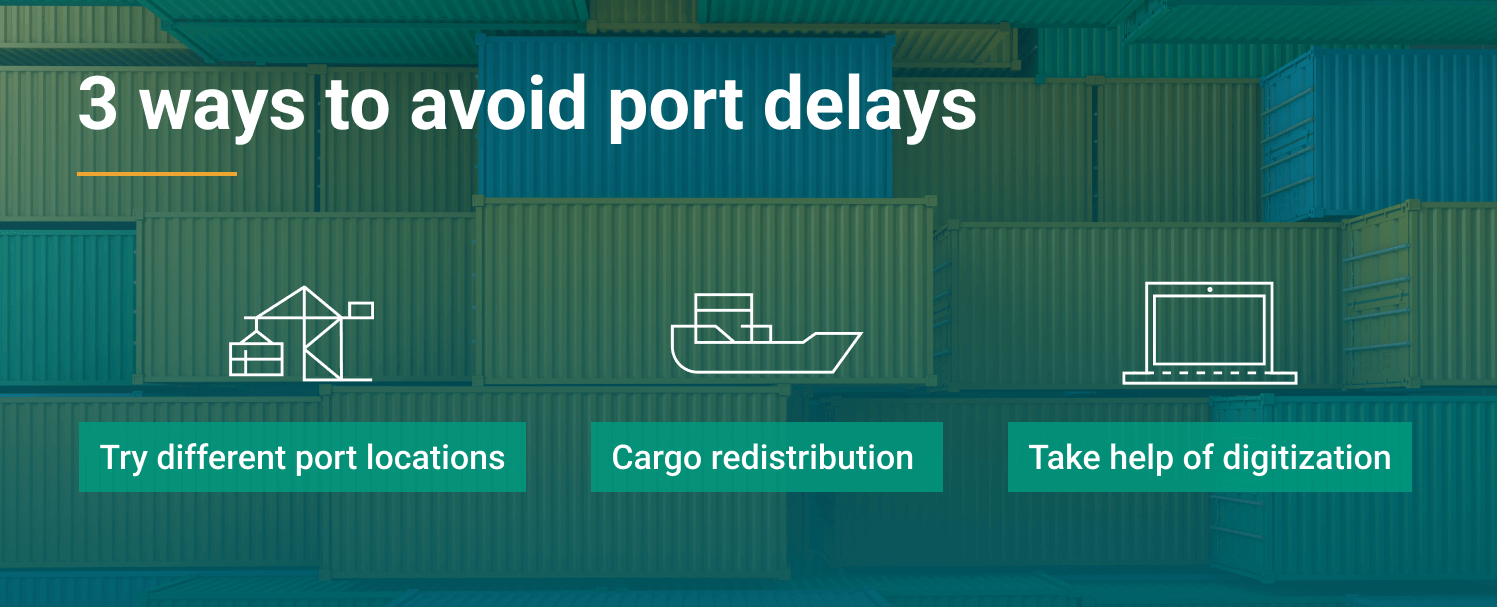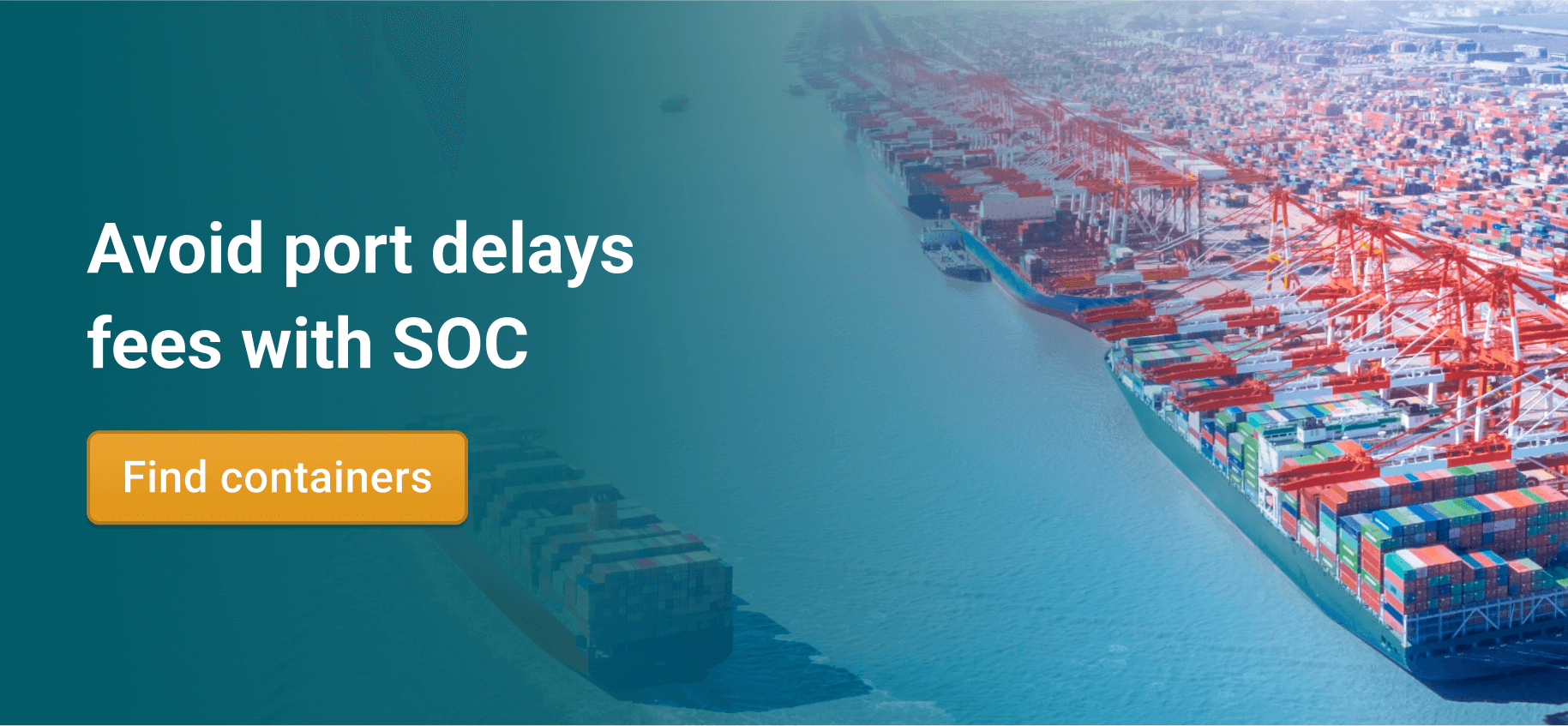Port delays can give birth to a number of shipping hurdles. Read this blog to know the top causes, impacts, and examples of port delays. Also, learn how you can save on late fees charged due to these delays.
If you’ve been in the shipping industry for some time, you’d know how delays at any step can cost you financially. And often, these delays are out of your control.
Port delays are one such shipping disruption that can give birth to a range of hurdles. Delays in handling vessels and containers can lead to congestion, overcrowded container yards, and high demurrage and detention charges. The Los Angeles port delays are the perfect example of this. We’ll learn more about this later in the blog.
Well, there’s not a lot you can do to solve delays at ports. But you can certainly increase your flexibility in shipping with SOC containers. You can also completely avoid these skyrocketing late charges caused by delays at ports. Wondering where you can get SOC containers from?
Just head over to our neutral marketplace to lease SOC containers from 1500+ vetted companies in 2500+ locations worldwide. Also, find vessel space for SOC boxes in minutes.
Try our public search below to find container offers. Simply select the container type, location and hit the search box to find containers now.
What is port delay?
The shipping industry is responsible for transporting the majority of goods. Even if the vessels arrive at the port on time, the loading and unloading of containers takes a lot of time, causing delays at ports. It’s a common occurrence and makes the shipping industry lose its valuable time.
To understand this better, let’s look at some of the common factors that cause these delays.
6 factors that cause port delays
Here are some of the common factors that cause port congestion and delays.
Low infrastructure capacity
A port’s infrastructure is directly responsible for its functioning. You’ll find it interesting to note that several ports in the world aren’t infrastructurally advanced to handle vessel traffic. This can be because of the lack of labor, machinery, and equipment. As a result, these ports experience delays and bottlenecks.
Vietnam is one such major shipping country that suffers from poor port infrastructure. There are often delays and bottlenecks in the ports of this major exporting nation. So much so that cargo owners experience losses of approximately US$2.4 billion each year.
Trade and container imbalance
Looking at the flow of goods at major trade routes, you can tell that there’s a trade imbalance in the world. When one region is primarily importing goods, the ports of that region are bound to be flooded with containers. So, these ports now have more equipment to manage, often causing delays.
This is what’s happening at the West coast ports in the US. We’ll soon get into details further in this blog.
Unforeseen events
Transportation of goods across the oceans comes with a risk of a lot of unforeseen events. This includes theft, bad weather conditions or accidents that can ultimately disrupt the supply chain and cause delays at ports.
The COVID-19 pandemic is one such unforeseen event that caused massive disruptions in the shipping industry. You can read more about the impact of the pandemic on the shipping industry in this blog.
Custom delays
Custom clearance rules and requirements are very strict. Your goods can only successfully pass customs if your container clearance and shipping documents are in order. Often, shipments fail to pass customs due to errors in these documents. And so, your goods along with the container get stuck at ports. This is an unnecessary hassle for port authorities, especially when it delays their processes.
Lack of digitization
Most procedures in the shipping process are still manual. This lack of digital solutions for logistics reduces efficiency and increases delays.
Lack of labor
Port operations include a series of complex maritime procedures — all aiming for a smooth import and export of goods. But to achieve that, ports need enough workers to carry out these procedures.
You’ll be surprised to know that even the most busiest ports in the world face labor shortages. In fact, the shortage of longshoremen, truck drivers, and warehouse workers have added to the delays at the Los Angeles and Long Beach ports in the US.

Delays at ports lead to port congestion. Here’s how that happens.
How port delays cause port congestion
Think of port delays as a traffic jam. If there’s a traffic jam, it’s obvious that you’ll take longer to reach your destination. Similarly, delays at port lead to shipping vessels lining up outside the port, waiting to get berthed.
If a vessel doesn’t get unloaded when it arrives at the port, it can lead to further vessels waiting for their turn. This is referred to as port congestion. And this congestion causes delays in the entire shipping process. You can learn more about port congestion in this blog.
Here’s a case study of how the Port of Los Angeles has been facing congestion triggered by delays at the port and vice versa.
Case study: Port of Los Angeles delays
The twin ports of Los Angeles and Long Beach have been in the news for some time due to the delays. These two ports are two of the busiest ports in the US and are responsible for receiving most of the cargo.
During the Covid-19 pandemic, the demand for goods skyrocketed because Americans were ordering more goods than usual. They also shifted to online shopping, thereby increasing trade and traffic on the China-US shipping route.
However, these ports couldn’t handle the increase in vessels. This ultimately led to port congestion and delays. On average, a vessel that takes nine days to unload was taking two weeks. This not only led to delays but also disrupted the entire shipping process.
Our Container Availability Index (CAx) shows whether a port is facing a container surplus or deficit. A CAx value > 0.5 means that more containers enter a port. And CAx value < 0.5 means more containers leave. By looking at the CAx values in the graph below, you can see the sudden increase in the influx of containers in 2020 and 2021 at the Los Angeles port.

Now the situation is a little better. The queue of vessels waiting to unload goods has fallen 80% since the start of the year. But the Los Angeles delays are a good example of how delays at ports can disrupt the entire shipping process. Read on to find out the impact of delays.
Impact of port delays
Here are some of the most common impacts of delays at ports.
Delay in manufacturing and sales
There can be a delay in the manufacturing of your products if the containers of raw materials don’t reach you in time if the vessel contains raw materials for manufacturing. Similarly, if there’s a delay in the delivery of finished goods, the sales can also slow down.
Lowers cash flow
Delays at port lower the cash flow. The more time it takes to unload the cargo, the more money is tied up in inventory.
Increases risk of damage
The longer cargo stays in transit, the more it’s exposed to the risk of damage. This is especially true for perishable goods like food or medicines. Moreover, the risk of container damages also increases.
Causes environmental pollution
Most ports use diesel and other fossil fuels for operating machinery. A delay increases the release of greenhouse gasses in ports as it takes more resources to handle port congestion. Shifting to sustainable ports can increase efficiency and reduce pollution.
Increases demurrage and detention charges
If your company is using COCs (carrier-owned containers), you’ll have to pay demurrage and detention (D&D) charges if there’s a delay at the port. These charges can quickly add up as they’re calculated on a per-day basis.
Read on to know more about D&D charges and how your company can avoid them.
Use SOC containers to avoid paying demurrage & detention
If you’re already aware of D&D charges, take a look at our Demurrage & Detention: Annual Benchmark 2022 report for free to get an in-depth overview and industry insights about D&D charges.
If you’re not aware, let’s first understand what D&D charges are.
- If you’re using COCs or carrier-owned containers, your company gets a certain number of free days to use them.
- It’s usually 3 to 5 days after the container has been discharged from the vessel.
- If you fail to return these containers back to the carrier within those free days, you’ll have to pay a late fee called demurrage and detention.
- A demurrage fee is charged when the container is delayed within the port. A detention fee is charged when it’s delayed outside the port.
We’ve already looked at the causes of delays at ports and most of them are not in your company’s hands. It can be dreadful to pay for D&D charges in a situation such as bad weather conditions. But there’s a way you can escape from D&D charges altogether. The best way to avoid paying is by simply using shipper-owned containers (SOCs).
These containers give your company more flexibility, control and independence. Since these containers aren’t owned by carriers, you’re no longer obliged to pay D&D charges to them. You can lease SOCs for one-way transport and return them to your partner’s depot at the port of destination.
Most of the time you don’t even have to pay any per diem charges. This is because this agreement benefits the container owners as well. It allows them to relocate their containers for free. It’s a win-win situation.
Interested in leasing SOCs? Or do you just want to know the leasing rates on your route? Just click on the banner below to get answers to all your questions.
3 ways to avoid port delays
Although using SOC gives your company relief from D&D charges, delays at ports are still a nightmare. Here are some tips to avoid them.
Try different port locations
One of the easiest ways to avoid delays is to use alternative ports. Most countries have more than one port, so why not ship your cargo to a port that’s not congested.
You’ll find it interesting to know that this is how the US importers have been seeking relief from the bottlenecks on the West coast ports. A major portion of the vessel traffic is now shifting to the East coast ports in the US.
Cargo redistribution
Your company can also redistribute cargo to various vessels. It increases the chances of your cargo getting cleared early.
Take help of digitization
Using digital solutions can help your company become more efficient. In fact, the port of Los Angeles is tackling the congestion by using digital tracking to get a full picture of the vessels headed their way.

xChange also provides various digital solutions for logistics that can help you at various stages of your shipping process. One of them is an online marketplace for SOC containers and vessel slots.
Book SOC containers and vessel slot on Container xChange
SOC containers help you avoid paying D&D charges, which are associated with delays at ports. But, where can you find SOC containers? And once booked, how can you find the slots on vessels for your boxes?
Well, xChange has got you covered. Once your company becomes a member on our platform, you can quickly connect with vetted container suppliers on our neutral container leasing marketplace. Simply search for the type of containers you want on your route and get a host of leasing offers from suppliers. Compare all the results, including the leasing charges, and book container deals that suit you the best.
Once your order is confirmed, you can book slots for your boxes on vessels too. We understand that booking slots is a tedious task. It’s manual, involves financial risk, and most times carriers prefer COCs over SOCs. It’s a never-ending problem where your company books SOCs but can’t find slots. And if slots are booked, SOC boxes are not confirmed.
However, with xChange, you can make both these bookings in minutes. Our leasing platform is your solution for booking SOCs. And our Ocean Freight Marketplace is your go-to solution for booking vessel slots for SOC containers. All you have to do is enter your route and get offers from various NVOCCs and carriers in one dashboard. You also get complete freight rates upfront, so you can take your time to compare and book the best deal.
So what are you waiting for? Click on the banner below to see how to book containers and vessel space in just a few minutes. Our experts will show you the platforms and answer all your queries. Give it a try now!
What is the impact of port delays?
Delays at ports can lower cash flow, increase the risk of damage, and lead to delayed manufacturing and sales. Delays at the port can also increase the demurrage and detention charges.
How can port delays be avoided?
Some of the best ways to avoid port delays are to try alternative port locations and opt for cargo redistribution. Shippers can also take the help of digital solutions to plan the logistics better.


